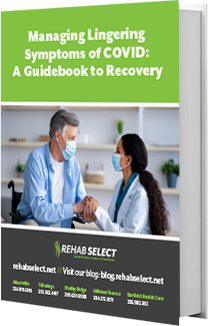Until late 2019, COVID-19 didn’t even exist. Today, we are still left with some questions about dealing with the virus and, fortunately, many answers as well about how to prevent and recover from the illness. While the disease may affect any given individual unpredictably, we know that older people with certain health conditions are the most vulnerable to long-term effects.
As a comprehensive rehabilitation facility, we have been on the front lines of the pandemic, caring for many who were too sick to go home but not sick enough to remain in the hospital. During this time, we have organized our extensive resources into a COVID recovery program for those with lingering symptoms.
This is your guide to the many facets of COVID recovery. Although cases are likely to continue far into the future, we are confident that you can get back to your normal lives post-illness by understanding and responding to the diverse challenges you or your loved one might face.
We are confident that you can get back to normalcy after COVID-related illness, by understanding and responding to the diverse challenges you or your loved one might face. Fill out the form to download our free guide to start today.
Click a link to go directly to a specific section.
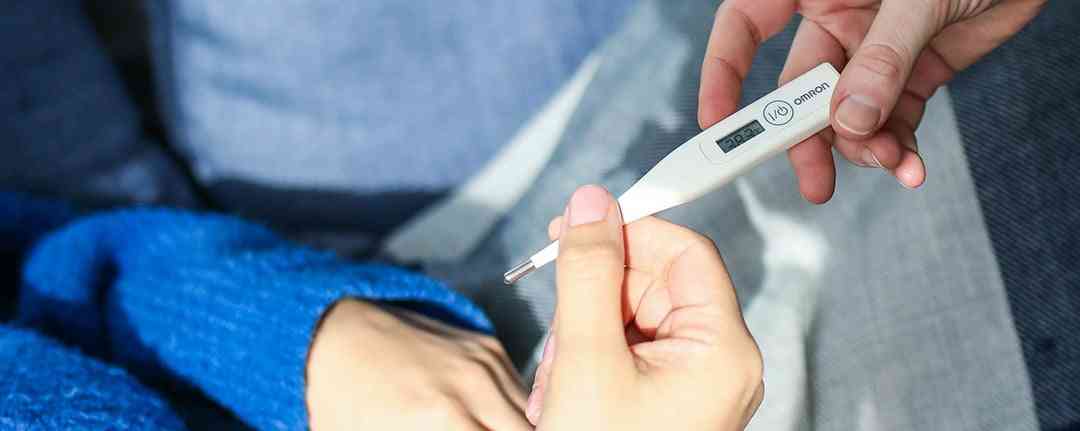
What is it like to have COVID? The answer to that varies greatly. While some who contract the virus are asymptomatic, others may be affected as if they have a common cold or flu. Others may experience a rapid escalation of respiratory symptoms that require hospitalization. In a recent survey, up to 35% of adults who tested positive for COVID 19 report still feeling the effects of the infection two to three weeks after diagnosis. In severe cases, especially if left untreated, the virus can cause lasting effects to the lungs, heart, and brain.
No one can predict what it will be like for you based on his/her experience. Symptoms such as those listed below often manifest between 2 and 14 days following exposure, and most people recover fully after 2 to 6 weeks:
Severe cases of COVID-19 are those in which symptoms either snowball or linger and cause damage to major organs. For example, fluid buildup in the lungs can lead to pneumonia and tissue damage. Your body’s immune response can precipitate a wide variety of other infections and dysfunctions:
The majority of adults who contract COVID-19 make a full recovery in just a few weeks; however, those with pre-existing health conditions or severe cases often deal with side effects for weeks after the infection. The term “COVID long haulers” is used to describe adults who still feel symptoms a month or more after diagnosis. Here are the most common long-hauler symptoms:

This frustrating array of secondary issues is disruptive to everyday life for long-haulers. The rehabilitation therapies now available have centered around this group’s multi-faceted recovery needs. Physical and occupational therapies along with complementary activities such as mobility training and psychological counseling can put normal within reach. If you or someone you care for still has difficulties related to COVID 4 weeks after diagnosis, you may benefit from a COVID recovery program.
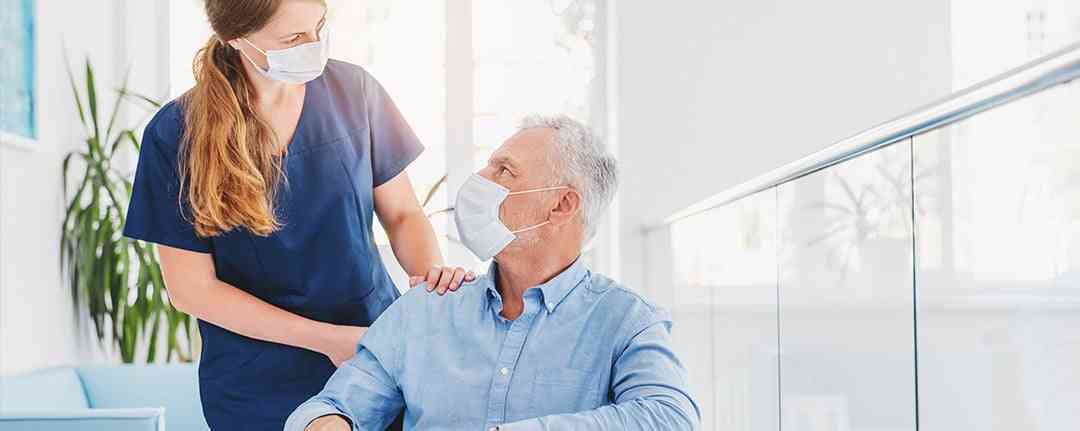
As you can gather from the myriad symptoms noted above, the virus affects each person differently and can exacerbate individual conditions. The purpose of a COVID recovery program is to help long haulers recover functionality as much as possible and to prevent further deterioration. Rehabilitation care facilities have been on the front lines of COVID recovery, and we found ourselves well-suited to respond to the needs of patients even after they are no longer infected.
Treatment protocols may primarily use occupational therapy, physical therapy, speech therapy, and counseling. Still, medical attention as needed, as well as physician oversight, is an essential component to recovery. Pulmonologists, cardiologists, nurses, and other physicians need to be close at hand to the therapy team to coordinate care properly. Medical monitoring by nurses and physicians will further reaffirm progress and help the team focus its energies, while also detecting any abnormalities. Nurses can quickly respond to temperature, heart rate, blood pressure, oxygen levels, and other vitals.
Occupational therapy aims at helping you perform activities of daily living or make adjustments so that you can adapt to new situations. COVID can place obstacles in the way of work, hobbies, social life, or even self-care.
Occupational therapists can help you address movement patterns of dressing, bathing, walking stairs, grocery shopping, and doing laundry. They can even help with activities affected by “brain fog,” such as grocery lists and managing medications.
As your therapist assesses your abilities, he/she may provide adaptive equipment and modification recommendations to help you function better.
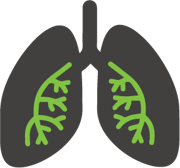
COVID-19 recovery often leads to inherent losses in muscle strength or lung capacity. Physical therapy can help bolster these weaknesses. Physical therapy helps you regain abilities in a safe and gradual way, working around long-haulers’ general fatigue. Methods may include manual and mechanical, active and passive techniques:
Did you know “pursed-lip” breathing can improve anxiety and shortness of breath? A speech and language pathologist has a deeper toolbox than many people know. They can address any muscular mental process that accompanies communication. Swallow training, also their realm, can help patients avoid dehydration and nutritional deficiencies.
Far beyond a normal cold, COVID-19 affects the body and mind. The isolation of the pandemic and actually having the virus can lead to mood changes and confusion. Counseling is an important part of recovery; your best life is still within reach, and believing in your future is key to getting better.
Modern science can give us antibodies we did not have to earn the hard way. We are offering the latest monoclonal antibody combination therapy, which has been granted emergency use authorization by the FDA, a combination of bamlanivimab and estesevimab. If you recently tested positive for COVID-19, this treatment can keep you out of the hospital and help you avoid a long recovery process.
By using cloned antibodies identical to those produced by healthy people who are fighting the virus, at-risk populations can reduce the severity of their illness. B cells, such as these monoclonal antibodies, have one job in the body, to destroy the spike protein that allows the coronavirus to attach to healthy cells. On February 9, 2021, the FDA issued an emergency use authorization for the combination of two monoclonal antibodies, bamlanivimab and etesevimab (prior to April 19, 2021, bamlanivimab was used alone but now seems to work better with etesevimab) to keep mild and moderate COVID-19 symptoms from advancing.
A University of Pittsburgh Medical Center study analyzed the first 230 patients who had received a monoclonal infusion. The treatment decreased the risk of hospitalization and death by 60% for those people who were the most likely to suffer complications (elderly, obese, those with diabetes or lung disease) if administered within ten days of first symptoms.
The monoclonal antibody infusion is a one-time IV treatment for COVID-19 recovery that administers the antibodies directly into the bloodstream. We offer it appointment-only, but it only takes 2.5 hours to complete.
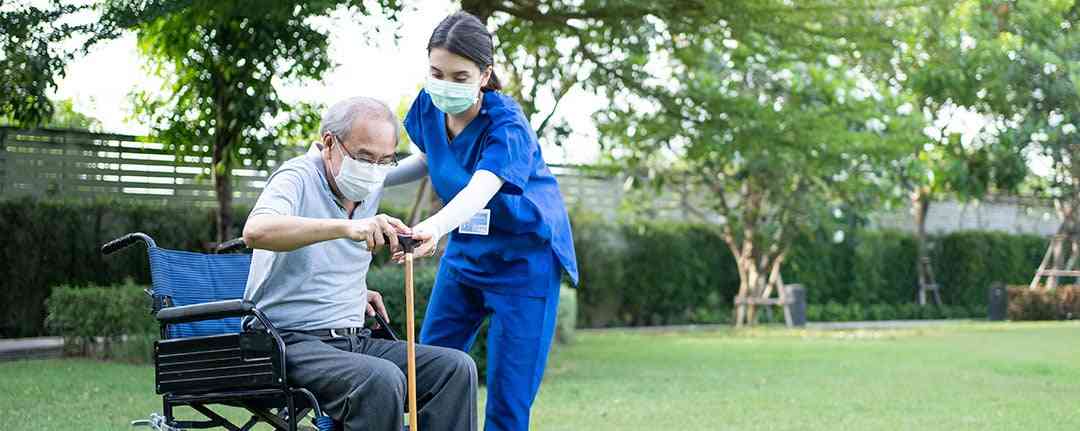
Physical Symptoms of COVID-19 originate in the lungs and affect other areas of the body. The mental strain and physical inactivity of recovering from physical symptoms can ripple into every area of wellbeing. The tools for COVID recovery thus range from physical therapy and strength training to deep breathing meditation practice and self-talk strategies.
As a respiratory illness, COVID-19 affects the lungs and breathing most directly; lung damage is one of the most common long-term effects from COVID-19.
Typical lung-related symptoms such as shortness of breath or difficulty breathing are often present even in mild cases. Some adults then can develop pneumonia or acute respiratory distress syndrome, which complicates breathing longer-term.
In severe cases or with long-haulers, COVID causes lung tissue damage that has to be addressed even after the body has expelled the virus itself (i.e. no longer testing positive for coronavirus). This damage may be related to inflammation, clots, and interstitial lung disease.
When you can’t seem to fully bounce back from COVID-19, shortness of breath is usually part of the problem. Your lungs can recover their function, and breathing better is within your reach with stepwise physical therapy, breathing exercises, and skills strengthened from occupational therapy or even yoga. Most of all, staying active to the extent possible will help you maintain cardiovascular health to recover.
Physical therapy is an important aspect of long-term lung tissue recovery. Recovery can take anywhere from a few months to a year or more as the tissues in your lungs heal with the help of a targeted treatment program.
A physical therapist makes an initial assessment by taking baseline measurements such as capacity testing and musculoskeletal evaluations. Then, they build an individualized plan based on your limitations to help you make stepwise improvements.
Core exercises, cardiovascular activity on machines or treadmills, and breathing techniques can address both muscle loss and lung efficiency. Diaphragmatic breathing, specifically, has a far-reaching effect on wellbeing.
Physical therapy over time improves lung capacity via cardiovascular endurance, muscle strength, breathing, and posture. Your therapist is critical to helping you find appropriate levels of fatigue and judge progress as you gradually resume normal activities.
Muscle weakness and fatigue emulate from the pulmonary strain as well as the sedentary initial recovery process. As you know, when it’s hard to breathe, you have less energy; when you move less, you lose muscle tone. And being sick always seems to require slogging through fatigue during recovery. As rehabilitation experts, we know these mutually compounding issues well. Even after the root causes have been addressed, we pursue the far-reaching effects of COVID.
The weeks of bedrest around COVID-19 can cause significant muscle loss, especially for the elderly. The elderly can lose 10% of muscle strength in one week of bed rest. Further, it seems COVID-19 may also cause actual damage to the muscles. A study published by the Centers for Disease Control and Prevention (CDC) suggests that rhabdomyolysis, the breakdown of muscle tissue, may be a side effect of COVID-19 in some patients. Learn more about our approach to maintaining muscular fitness.
During rehab, your physical therapists will develop a customized program of exercises that will help you rebuild your muscle strength, flexibility, and tone where you need it most. Often, this prioritizes core and postural muscles in the abs, lower back, glutes, and hamstrings. The focus of occupational therapy will be on performing basic daily activities to help you get back to normal life after COVID as quickly as possible, finding workarounds for difficult activities, and helping with better specific patterns of movement. Therapists will employ mobility training and strength work using bodyweight, bands, machines, and simulating common activities.
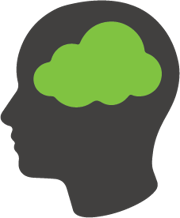
Brain fog describes the feeling of having sluggish and fuzzy thinking. Brain fog can be a symptom of flu, jet lag, or sleep deprivation. It seems especially common for COVID long-haulers. Encountering a well-publicized, life-threatening virus is unnerving; the COVID infection itself is no easier physically; isolation and lack of normal social routines increase the disassociation. Thinking and memory do usually recover from brain fog. Our rehabilitation approach helps spark clearer thinking and a better mood.
Researchers believe the underlying inflammatory conditions, silent strokes, and persistent lack of oxygen may contribute to brain fog directly. They are certain that ICU stays can cause anxiety, depression, and post-traumatic stress disorder. Further, sleep deprivation is common amongst the stress and discomfort of COVID. Researchers found that sleep deprivation disrupts our brain cells’ ability to communicate with each other, causing temporary mental lapses and affect memory. So, if you are finding it harder to think, reason, and focus, after coronavirus, it is not your imagination. Lifestyle changes and a combination of occupational and cognitive therapies can help cut through the fog.
Cognitive Rehabilitation Therapy is part of our solution to brain fog. Our speech and language pathologists help identify exercises to improve memory processes and rebuild neural pathways. This could include memory training exercises and methods, mental exercises, and speech therapy. Speech and language pathologists follow the flow of communication processes from the brain to the production of speech to help you maintain clarity in thinking and responding to the world.
An occupational therapist can provide you with mental training tools and exercises to optimize your thinking abilities as you work through the physical, mental, and cognitive challenges caused by COVID. They will also provide tools and suggestions for specific difficulties, whether it’s making a more organized grocery list or designing your office to better maintain focus.
Further counseling can be necessary for long haulers who may be highly discouraged by such a daunting recovery process versus what they expected.
Anyone who contracts the virus is at risk for some COVID anxiety and depression, but long-haulers are more vulnerable. According to a recent CDC study conducted between August 2020 and February 2021, the percentage of adults with symptoms of anxiety or depression rose from 36.4 percent to 41.5 percent.
Even those who have never been depressed might feel downtrodden after thinking they should be better just to find that real recovery seems to stretch out indefinitely. According to a Lancet article published November 2020, nearly 20 percent of those who had COVID-19 also developed a mental health issue within three months of diagnosis. Those who had COVID-19 were twice as likely as those who had not to develop issues such as covid depression, anxiety, or dementia.
Therapies and techniques that help with brain fog also help with depression and anxiety because the same factors contribute to both: sleep deprivation, isolation, lack of blood flow, fatigue, etc. Countering the effects of extended isolation is a major focus of our occupational therapists and speech and language pathologists, both of whom offer invaluable help in reclaiming normalcy by working around difficulties. We have all been somewhat disconnected for over a year, and regaining the confidence to communicate and participate in social life is a critical part of mental health.
Psychological counseling helps patients see the world in a more optimistic way. Developing patience and self-confidence is key to getting the most out of the COVID recovery program. We offer patients the chance to participate virtually or in person.
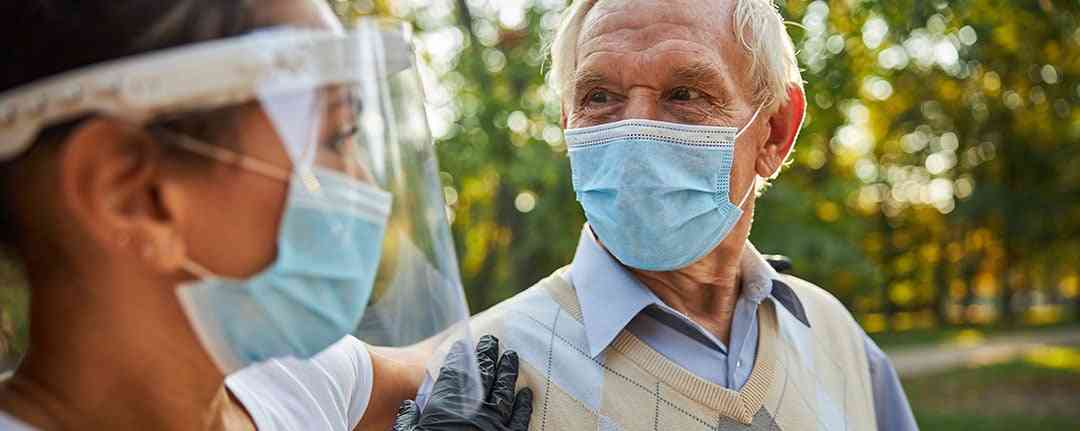

Coronavirus outcomes vary from person to person, so you’ll need an ever-evolving response to recovery.
You will need physical therapists to coordinate with physicians and nurses to communicate with speech language pathologists. Any of these might recommend additional counseling and perceive developments the others might have missed.
An individualized plan may follow you home, with virtual sessions and regular checkups, so that you can integrate into normal life at your own pace. Specialties can intervene only as necessary to maintain progress.
By monitoring your progress closely, you and your doctor can recognize symptoms early and adjust treatment as necessary. It is best to have a diverse team of physicians, doctors, and therapists monitoring your conditions over time so that one bias does not allow part of your regimen to be neglected. Your recovery team should give you the tools to help monitor your symptoms and report them accurately as you transition to normal routines.
Research shows we may be underestimating the impact of Coronavirus on sarcopenia and physical deconditioning. As we’ve learned, the elderly can lose strength rapidly, and muscle tissue not exercised will atrophy. COVID recovery by nature is sedentary at first. Of course, this exacerbates all of the physical and mental symptoms we’ve discussed. Moving toward full functional mobility and regular exertion is a priority that everyone on your team should share.

Research has found that most people recover with holistic support, rest, symptomatic treatment, and a gradual introduction to “normal” life and activity. We are the ideal environment to offer that staging toward regular life routines.
We know that recovery is not always linear. You’ll need confidence to move through setbacks, flare-ups, and persistent difficulties; our knowledgeable team will nonetheless find creative ways to keep you moving and healing.
Coronavirus is part of everyday life for the foreseeable future. There will still be infections, and the vast majority of people will go on living their lives afterward. We are here to make sure no one gets caught in between, left in limbo virus-free but still unable to function normally. At Rehab Select, we take a multi-faceted to helping COVID-19 patients heal and ensuring everyone can have a good quality of life on the other side of infection.
If you or a loved one have recently contracted COVID-19 and would like to find out more about our care, contact us about monoclonal antibody infusion. If you are dealing with lingering after-effects weeks or months after having symptoms, learn more about how we can individualize a COVID recovery program for you.
